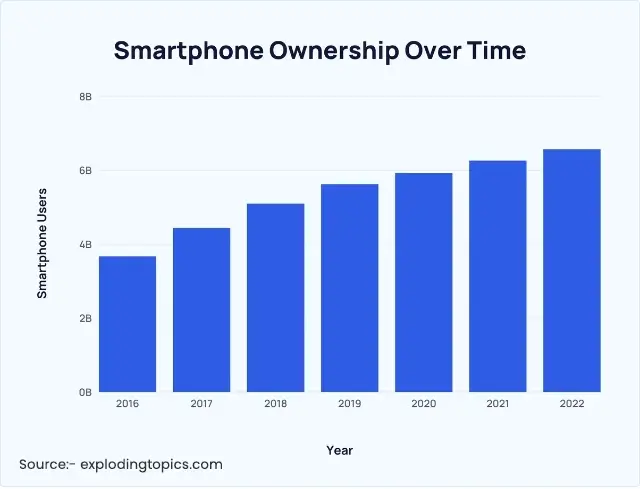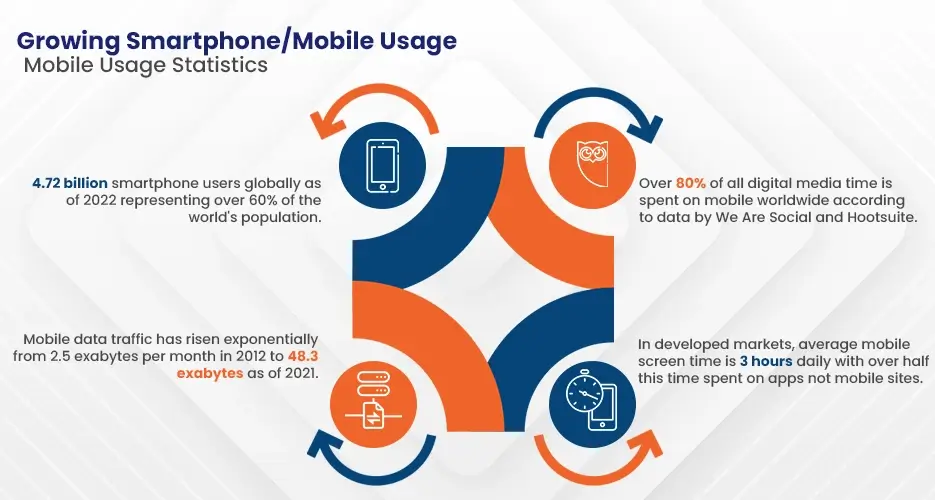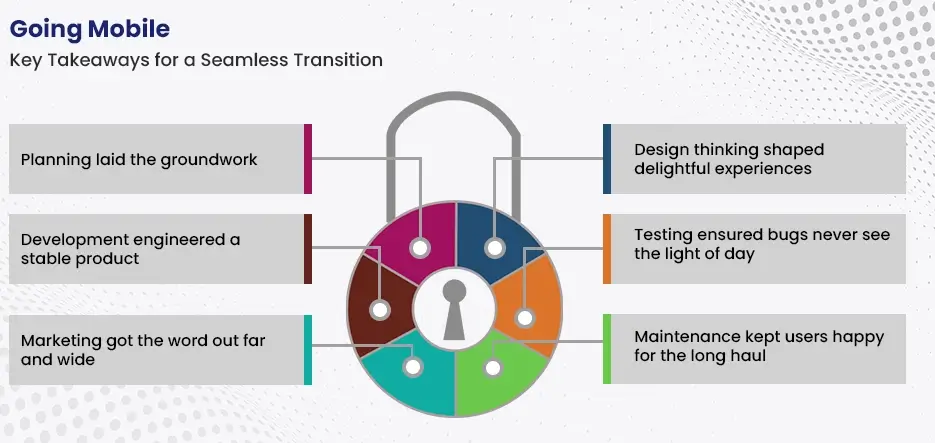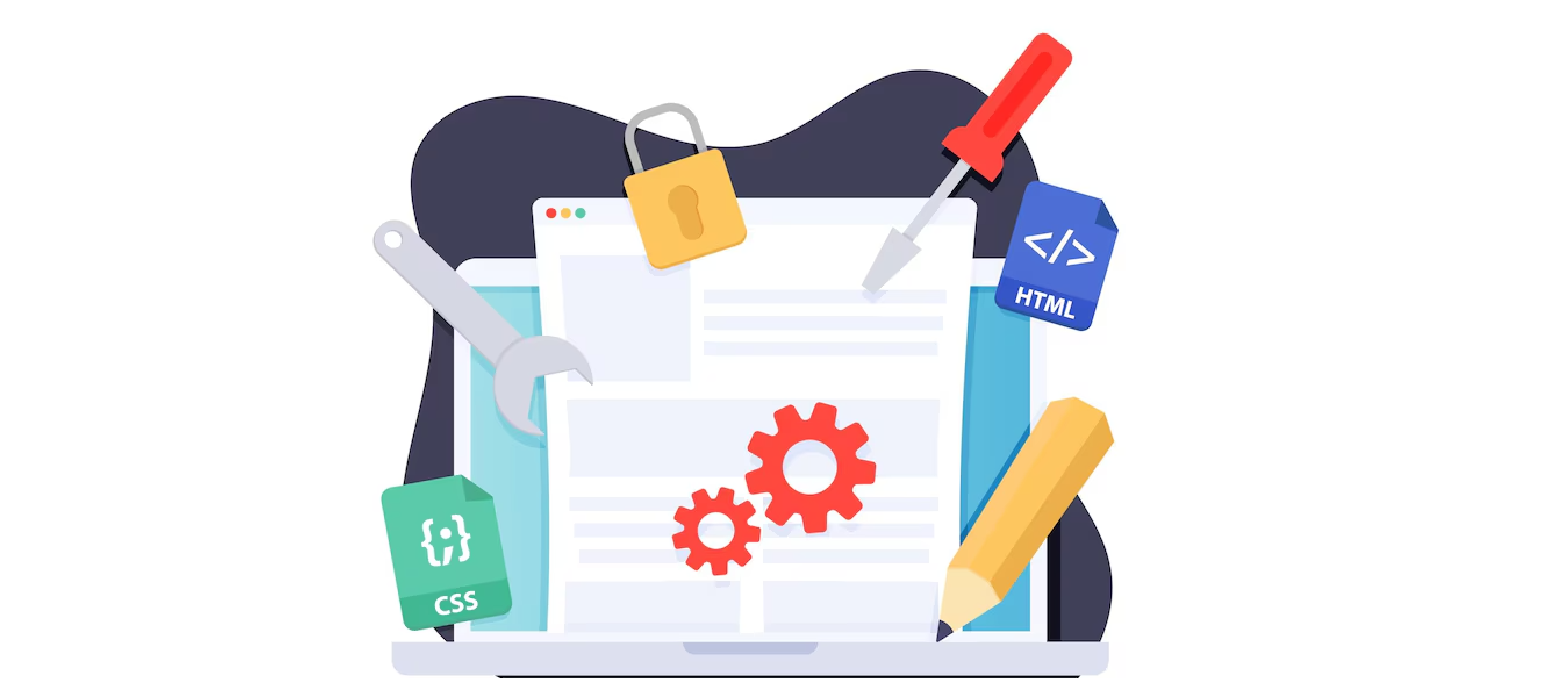Table of Contents
Are you thinking to turn website into mobile app? Unable to understand where to start? You have certainly landed in the right place.
Over 85% of the global population now owns a smartphone. Users spend 3 hours daily on their devices. This proliferation has expanded the mobile landscape tremendously.
A responsive website design adapted for multiple screen resolutions is essential for visibility on mobile search and discovery. However, native apps offer a superior experience driving engagement further:

- 80% of all online time is spent on apps not mobile web according to Flurry Analytics, proving their stickiness.
- 51% of all app users open an app daily highlighting their integral role in user routines according to App Annie. This engagement level is hard to replicate for even best-designed mobile websites.
- Apps on average see a 25% reduction in bounce rate versus mobile web as per Amplitude, proving their effectiveness in retaining users.
Native apps improve conversion rates and transactions by 22-30% on average compared to mobile sites as per Pitney Bowes, fostering greater ROI.
With advanced push notifications, home screen shortcuts and offline functionality, apps have become indispensable aids empowering users’ mobile experiences. Building such differentiated touchpoints strengthens competitive advantages in today’s app-dominated mobile ecosystem. So, it is important that you convert your website into mobile app. If you are thinking what it is all about, then we have the answers for you in this detailed guide. Let’s begin
Growing Smartphone/Mobile Usage
Smartphone penetration has exploded globally in the last decade, driven by affordable devices and network coverage expansion. Some key statistics:
- There are over 6 billion smartphones worldwide currently representing 75% of all phones.
- Smartphone sales surpassed basic phone sales in 2016 and the gap is widening annually.
- According to Cisco projections, mobile data traffic has grown 12-fold since 2016 and will increase another 7 times by 2022.
- Users engage highly with mobile, especially for content discovery, purchases, and messaging activities.
With mobile emerging as the primary digital platform, optimizing the user experience across different screen sizes for smart businesses has become imperative.

Importance Of Having A Mobile-Friendly Presence
Smartphones unlocked new ways to engage users through apps. Top enterprise mobile app development companies exploited this potential creating deeply immersive experiences.
- According to App Annie, the global app economy reached $6.3 trillion in revenue in 2022, driven by consumer spending on both free and paid apps.
- In the United States alone, users spend 87% of their mobile time using apps compared to only 13% browsing mobile web pages.
Quality Mobile Experiences
Satisfying burgeoning mobile customer expectations necessitates an optimized presence across all digital touchpoints including custom app development services.
User Acquisition & Engagement
Compelling mobile optimized content and an app accelerate user acquisition 5X lower cost versus traditional methods. Engagement also improves with apps holding 30% higher session times than mobile sites. Repeated usage cultivates loyalty crucial for business success.
Improved Brand Perception
Customers form lasting impressions from their initial digital interactions. Well-designed mobile properties display a brand’s commitment and ability to understand evolving customer needs, positively influencing perception. This boosts preferences and purchase propensities.
Better Conversions
As per the top mobile app development companies in USA, mobile apps convert 4X more visitors into customers compared to mobile-optimized sites. Their full-screen interactive format and push notifications facilitate impulse transactions. Conversion rate optimization through A/B testing also refines experiences continuously for maximal revenue.
Return on Investment
Well-promoted apps featuring frequent updates retain customers generating long-term value. Average annual revenue per app reaches $34,000 according to Statista. Lifetime customer value multiplies in comparison when a single visit alone on a website generates mere cents. The ROI from apps outweighs development and acquisition costs over time.
Market Positioning Advantage
According to mobile app consulting companies in USA, progressive enterprises appreciate the strategic importance of embracing new technologies. Feature-rich iOS and Android app development establish thought leadership cementing their position at the forefront of industry innovators. This reinforces differentiation and strengthens competitive moats.
So, the mobile imperative demands optimized experiences upholding superior UX, conversions, and retention metrics. Strategies integrating quality apps, responsive sites and other digital assets optimize omnichannel touchpoints, future proofing businesses.
Let Experts Help you Convert your Website into Mobile Apps as per your Custom Needs!
Advantages of Developing a Mobile App over a Responsive Website
As per the top iOS and Android app development companies in the business, below are the perks of transforming a website into a mobile app. Check it out.
Benefit #1 – Enhanced User Experience
Apps offer truly native experiences through hardware-enabled features like touch gestures, camera/GPS integrations etc. Leveraging these along with elements like home screen shortcuts, notifications and in-app browser create seamless, intuitive flows pleasantly surprising users daily. Responsive sites lack such transformative abilities despite their convenient resizing, falling short on delivering optimal mobile-centric experiences.
Benefit #2 – Increased Engagement
As per the leading mobile app development companies, websites confined within browsers cannot match apps’ level of user retention and frequency of use. Optimized for one-handed usage, apps strategically showcase content keeping people engaged for prolonged durations. Their focused formats lend better attention and discoverability compared to websites demanding divided focus. Users open native apps an average 56 times per month against websites’ usage primarily for desktop access.
Benefit #3 – Improved Discovery and Searchability
Downloads and initial user acquisitions overwhelmingly take place through app stores, not mobile search. Central listings permit optimized presentation boosting discoverability massively. Custom graphics, categories, reviews and search-optimized metadata assist effortless discovery in curated app store environments as against ranking challenges for any given keyword on search engines. This taps primary user habits driving fresh installations.
Benefit #4 – Opportunity for Deeper Engagement
Websites relying majorly on articles and links can only go so far in retaining audiences. Apps facilitate interactive content presentation better via formats such as push notifications, login features, maps/AR functionality and multi-view configurations optimized for mobile consumption. Their immersive formats engage subsets of relevant users in uniquely interactive experiences driving heightened loyalty.
Benefit #5 – Opportunity for In-App Monetization
While websites primarily generate revenue from advertising and referral links, apps activate lucrative monetization options like one-time/subscription pricing, in-game purchases and tipping. Leveraging such platforms optimized especially for microtransactions, apps have created highly profitable models across industries like gaming, streaming and dating. The tech allows effortless commerce at every engagement touchpoint elevating recurrent user value.

Benefit #6 – Enhanced Brand Loyalty
Frequent app launches integrate brands seamlessly into customers’ mobile routines alongside their favourite tools and pastimes. This builds stronger emotional connections than websites sparingly visited. Home screen placement akin to other beloved apps cultivates brand advocacy as users commend them among peer circles. Subconscious familiarity further drives unaided recall and preference in the long-run, deepening relationships.
Benefit #7 – Access to Valuable Usage Insights
Mobile app localization uniquely facilitates understanding user behavior patterns and pain points through analytics of activities performed within. Datapoints covering elements such as in-app time spent, recurring features used etc. aid refining the app constantly as per emerging needs. With consent, they even track offline engagement factors providing unprecedented visibility unattainable otherwise. Resultant optimizations multiply user value, retention and likelihood of recommendations.
Benefit #8 – Expand to New Platforms and Devices Easily
Ever-diversifying platforms like smartwatches, AR/VR headsets are carving newer mobile frontiers. While websites cannot dynamically adapt across devices, apps optimized natively for individual OS allow smooth accessibility everywhere. Professional or free app builders easily configure builds targeting latest entrants avoiding ground-up creation. Further, cross-platform mobile app development tools aid rapid migration helping businesses stay ahead of the curve, reaching untapped audiences. This future-proofs the proposition versus rigid websites dependent on desktop browsing alone.
Benefit #9 – Improved Perception and Credibility
Relative to general websites, featured app listings imply an elevated commitment to serving customers through dedicated software. Their personalized touch conveys prestige for any brand while reflecting technical aptitude. A multi-platform ready app strengthens authority as a modern, customer-obsessed enterprise finely attuned to industry developments. This positive perception inspires greater confidence during initial engagement and future interactions, including commerce. Advanced apps also translate to improved ranking in app discovery algorithms like those of app stores and third party listings.
Benefit #10 – Simplified Maintenance and Updates
Websites require code edits and whole page refreshes for even minor improvements across all devices. Apps release optimized updates through centralized platforms on an ongoing basis, therefore automatically synchronizing experiences. Bugs fixes and enhancements roll out to all users simultaneously saving efforts compared to responsive websites requiring browser cache clears. Further, apps provide valuable usage insights for targeted betterments whereas websites lack visibility into actual user experiences.
Benefit #11 – Increased Conversion and ROI
By addressing customer pain points more intuitively, apps optimize conversions. Their streamlined in-app processes enable frictionless transactions. Features like push notifications trigger impulse purchases improving rates. Additionally, recurring monetization models generate long tail revenue surpassing one-time website conversions. Successful apps yield 3x higher annual user value versus responsive designs according to Activate. Remarkable ROIs have established the app economy now worth over $6.3 trillion in global consumer spending per year. These compelling commercial benefits motivate substantial app development investment ultimately paying for themselves.
So, native apps carry unparalleled operational advantages raising the stakes in customer experience, credibility, maintenance convenience and profitable growth – factors crucial for competitive differentiation, especially as the mobile landscape evolves. Their dominance as the preferred medium of consumer engagement underscores the strategic priority of this immersive format.
How To Convert A Website Into A Mobile App?
Below are the essential steps that can help you transform a website into a mobile app. Take a look:

Step 1: Analyze Website Traffic and Usage Patterns
The first step helps identify key sections that are frequently accessed on mobile devices. You need to determine popular pages, most used features, average session times etc. to prioritize what goes into the app. Understanding pain points like slow loading sections also helps design app flows. This mapping process ensures the app caters well to actual consumer needs and becomes the new gateway to maximize their experience.
Step 2: Define App Features and Flows
Leveraging traffic insights, list out key features and content to be included in the app version. Prioritize must-have over nice-to-have to focus efforts. Carefully map app navigation and information architecture to make contents easily discoverable. Design intuitive onboarding process and simple yet engaging in-app flows optimized for one-hand usage. Wireframing at this stage helps visualize look and feel improving upon website shortcomings. Essential features include account login/signup, push notifications, payments if any along with core website functions.
Step 3: Select the Right Platform
Choose whether to develop a native (iOS and Android) or cross-platform (React Native, Flutter, Xamarin etc.) app based on budget, maintenance effort and target user base. Native apps deliver superior experiences but require separate development while cross-platform solutions simplify updates at some cost to performance. Testing demand, your developers’ expertise and go-to-market approach also influence this decision. Prioritizing iOS and Android covers the largest mobile audience. Over 95% enterprise apps are now mobile, emphasizing the need to provide optimised experiences across devices.
Step 4: Design App Assets
Design visual assets like icons, graphics, screenshots within brand guidelines. Hi-fi mockups simulate the real app facilitating stakeholder reviews. Prepare copy for on-boarding flows, product descriptions and other in-app contents. Develop app store marketing assets such as hero images, long-form descriptions benefitting from search optimization. Launch collateral includes social media graphics promoting availability. This artwork creation streamlines app discovery and showcases its highlights even before release. Consistent branding consolidates first impression and trust with audiences.
Step 5: Develop the App
The development phase begins with front-end coding of all designed screens and flows. Back-end integration establishes crucial site functionalities through APIs. Thorough testing ensures flawless performance across various devices and resolutions. Mobile app security and monitoring implementation protects sensitive user data through credentials, encryption etc. Essential non-functional aspects include performance optimization, accessibility compliance and offline capabilities. Careful coding adhering to platform-specific guidelines delivers quality software minimizing bugs and returning greater satisfaction. User testing identifies scope for enhancements prior to official rollout.
Step 6: App Store Optimization and Launch
Once development wraps, optimizing app store pages becomes a priority. Tailor titles, descriptions, screenshots and metadata to suit individual store algorithms and user search keywords. Promote pre-launch through marketing campaigns to attain visibility. Address app reviewers’ feedback to ensure smooth approval. Officially launched by releasing the optimized build across targeted stores and simultaneously promoted through various channels to attract early adopters. Continuously monitor post-launch analytics and user sentiment for ongoing improvements. Regular updates build long term user loyalty.
Completing this process transforms websites into better-structured, mobile-specific applications delighting users with a true native experience. Careful planning and execution pays off through increased engagement metrics and business goals attainment.
Costing of Converting Website Into Mobile App
While there is no fixed cost for converting a website into mobile app, several factors influence the overall expense:
Project Complexity: Simple apps with minimum features cost less than complex enterprise-grade ones.
Platform Choice: Native iOS/Android apps are more expensive than cross-platform solutions.
Developer Experience: Senior developers charge higher hourly rates than juniors.
Tech Stack & Integration: Complex tech stacks and extensive third-party integration impacts cost.
Design Services: Polished UI/UX designs involving visual assets require design costs.
Testing & QA: Rigorous testing cycle to ensure stability adds to budget.
Maintenance & Support: Long-term support agreements factor ongoing costs.
Let’s understand how these variables affect average app development costs.
Average Cost Breakdown for Converting a Website to App
Planning & Analysis: $1,000 to $3,000
Design & Prototyping: $2,000 to $10,000
Development:
- Simple App: $10,000 to $30,000
- Moderate App: $30,000 to $60,000
- Complex App: $50,000 and above
Testing & QA: 10-15% of development costs
App Store & Marketing: $2,000 to $10,000
Maintenance Per Year: 15-25% of initial development
The simple cost breakdown serves as an initial reference, but actual project scoping determines precise budget needs. In the coming years, the onus remains on continually delighting users through constant refinement on an ever-evolving landscape of possibilities. This keeps businesses future-proof with a dedicated customer base.
Book 30 Minutes Free Consultations with A3Logics Experts to Start Your App Journey Today!
Final Thoughts
So, the strategic pivot to high-performing mobile apps elevates the user experience and long term commercial success of businesses as shown through prevailing industry examples. If you are looking for a reliable on demand app development company to help you with the conversion of a website into mobile app, then we can help. A3Logics has been one of the top names in the business. You can trust their team and get all the assistance in terms of converting website into mobile app. Good luck!
FAQs
Q1. How do I turn my website into mobile app?
The process involves analyzing traffic, defining features, selecting the best platform, designing app assets, development and launch. Reputed custom mobile application development companies like A3Logics help implement this seamlessly.
Q2. What is the average cost to convert a website to a mobile app?
On average, expect $10,000-$30,000 for a basic app to over $100,000 for complex enterprise apps as estimated by top mobile app development services experts in USA.
Q3. What platforms/tools are best for app development?
Popular cross-platform tools are React Native, Flutter and Xamarin. For native apps, Java for Android and Swift for iOS are widely used by leading iOS app development companies.
Q4. How much time does it take to transform a website into a mobile app?
The timeline ranges from 2-6 months usually. Complex apps with extensive features and integrations may take longer as informed by expert mobile application development consulting services.
Q5. What are some tips for app promotion and marketing?
Focus on app store optimization tactics like customized listings. Pair releases with campaigns on social media, blogs and owned channels for better discovery.






